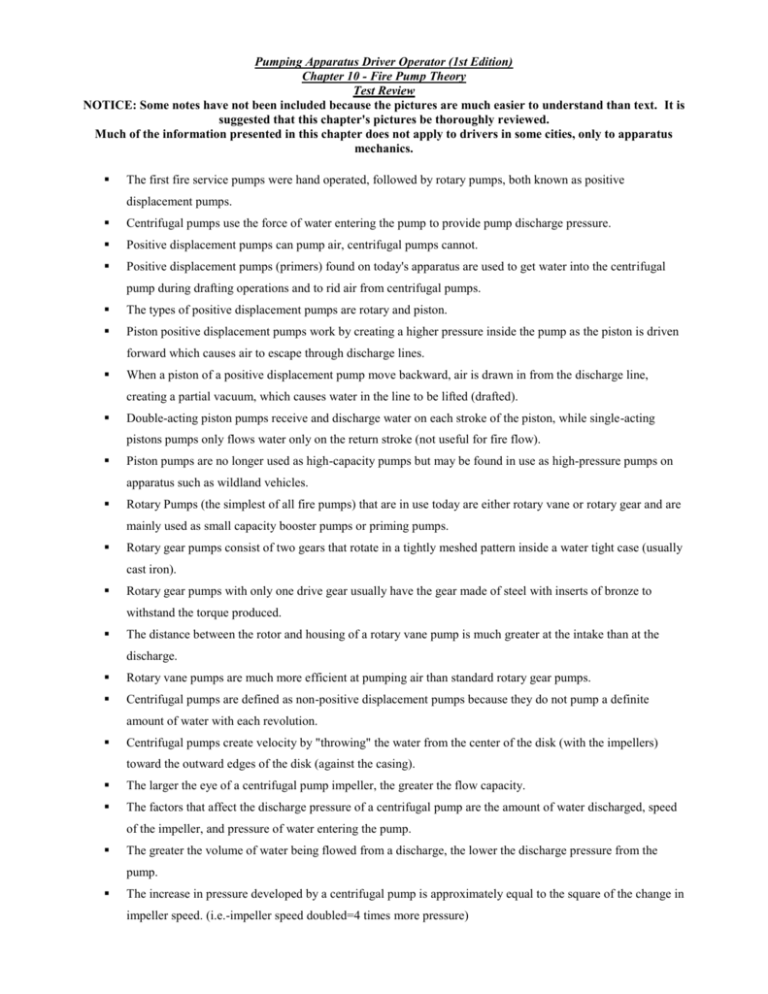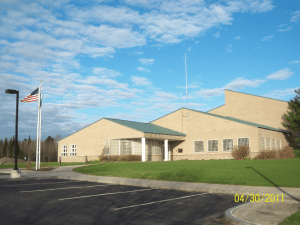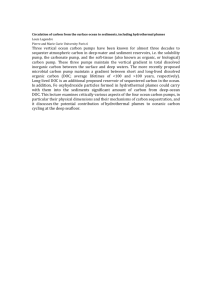Pumping Apparatus Driver Operator (1st Edition)
advertisement

Pumping Apparatus Driver Operator (1st Edition) Chapter 10 - Fire Pump Theory Test Review NOTICE: Some notes have not been included because the pictures are much easier to understand than text. It is suggested that this chapter's pictures be thoroughly reviewed. Much of the information presented in this chapter does not apply to drivers in some cities, only to apparatus mechanics. The first fire service pumps were hand operated, followed by rotary pumps, both known as positive displacement pumps. Centrifugal pumps use the force of water entering the pump to provide pump discharge pressure. Positive displacement pumps can pump air, centrifugal pumps cannot. Positive displacement pumps (primers) found on today's apparatus are used to get water into the centrifugal pump during drafting operations and to rid air from centrifugal pumps. The types of positive displacement pumps are rotary and piston. Piston positive displacement pumps work by creating a higher pressure inside the pump as the piston is driven forward which causes air to escape through discharge lines. When a piston of a positive displacement pump move backward, air is drawn in from the discharge line, creating a partial vacuum, which causes water in the line to be lifted (drafted). Double-acting piston pumps receive and discharge water on each stroke of the piston, while single-acting pistons pumps only flows water only on the return stroke (not useful for fire flow). Piston pumps are no longer used as high-capacity pumps but may be found in use as high-pressure pumps on apparatus such as wildland vehicles. Rotary Pumps (the simplest of all fire pumps) that are in use today are either rotary vane or rotary gear and are mainly used as small capacity booster pumps or priming pumps. Rotary gear pumps consist of two gears that rotate in a tightly meshed pattern inside a water tight case (usually cast iron). Rotary gear pumps with only one drive gear usually have the gear made of steel with inserts of bronze to withstand the torque produced. The distance between the rotor and housing of a rotary vane pump is much greater at the intake than at the discharge. Rotary vane pumps are much more efficient at pumping air than standard rotary gear pumps. Centrifugal pumps are defined as non-positive displacement pumps because they do not pump a definite amount of water with each revolution. Centrifugal pumps create velocity by "throwing" the water from the center of the disk (with the impellers) toward the outward edges of the disk (against the casing). The larger the eye of a centrifugal pump impeller, the greater the flow capacity. The factors that affect the discharge pressure of a centrifugal pump are the amount of water discharged, speed of the impeller, and pressure of water entering the pump. The greater the volume of water being flowed from a discharge, the lower the discharge pressure from the pump. The increase in pressure developed by a centrifugal pump is approximately equal to the square of the change in impeller speed. (i.e.-impeller speed doubled=4 times more pressure) Centrifugal pumps cannot pump air and must be used in conjunction with an external primer pump to remove air from the pump. Double suction impellers take water in from both side of the impeller eye which cancels lateral thrust and with the addition of discharges that remove water from the pump in opposite directions, radial thrust is also cancelled producing a "hydraulically balanced pump". Two-stage centrifugals pumps can be set to volume (parallel) operation where each of the impellers take water from the source and deliver it to the discharge or they can be set to pressure (series) operation where the first impeller takes in the water and partially pressurizes it and the second impeller provides an additional increase in pressure before discharging it. The process of switching a pump from volume to pressure position is sometimes termed changeover. Switching from volume to pressure operation will result in an immediate doubling of discharge pressure. Newer transfer vales on two stage pumps can be activated by electricity, air pressure vacuum from engine intake manifold (gasoline engines only), or by water pressure. If clapper (check) valves on two stage pumps stick open or become clogged by debris, the pump may not operate properly in the pressure (series) position. Clapper valves on two stage pumps can be checked by removing the strainers from all big intake openings, sticking a rod or similar item into the intake, and checking for free movement of the valve. Pump casings contain replaceable wear or clearance rings to maintain the desired spacing between the impeller hub and casing. Pump temperature can be checked (for overheating) by placing a hand on the direct pump intake pipe of the pump. Packing rings are used at the point where the shaft passes through a pump casing to prevent air leaks. Lantern (spacer) rings are used to cool and lubricate the heat and friction produced by shafts and the packing of packing rings. Auxiliary engine-driver pumps are powered by gasoline or diesel engines independent of the engine used to drive the vehicle and are commonly found on ARFF, wildland, and mobile water supply apparatus, and on trailer-mounted and portable applications. Auxiliary engine-driven pumps are ideal for pump-and-roll operations. PTO-driven fire pumps are typically found on initial attack, wildland, and mobile water supply apparatus. Pump gear cases on PTO-driven pumps must be mounted in a location that allows for minimal angulation of the drive shaft. PTO-driven pumps permit pump-and-roll operations, however, when the clutch is disengaged on the vehicle such as when changing gears during driving, the pump is stopped momentarily until the clutch re-engages. Pressure can also be affected by engine speed. Front-mount pumps use a step-up gear ratio so that the impeller turns faster than the engine. Front-mount pumps are move susceptible to freezing than body-mounted pumps. Front-mount pumps can be used for pump operations much in the same manner as PTO-driven pumps with the same drawbacks regarding engine speed and clutches. Power is supplied to midship transfer drive pumps through a transfer case located in the drive line between the transmission and rear axle. Midship transfer drive pumps cannot be used for pump-and-roll operations. Apparatus with rear-mounted pumps typically have more compartment space for tools and equipment. Rear-mount pumps may be power either by split-shaft transmissions (like midship pumps) or by PTO (allows for pump-and-roll). Components of piping systems include intakes, discharges, pump drains, and valves, and are most commonly constructed of cast iron, brass, stainless steel, and/or galvanized steel. The majority of all fires are initially fought with water from onboard tanks. Mobile water supply apparatus have multiple tank-to-pump lines (piping). Because of a check valve, tank-to-pump lines cannot be used to fill onboard apparatus tanks. Primary intake piping normally tapers to a square shaped pipe as it enters the pump which helps eliminate water entering the pump in a vortex (possibly containing air). Most discharges are equipped with a locking ball valve. Tank fill lines can be used to circulate water through the pump when no lines are flowing. The most common type of valve in apparatus piping is the ball-type valve which permits full flow with minimal friction loss. Push-pull valve handles use a sliding gear tooth rack that engages a sector gear attached to the valve stem and allows precise pressures to be set. Gate or butterfly valves are most commonly used on large diameter intakes and discharges and are operated by a handwheel (gate valves) or by a 1/4 turn handle (butterfly valves). Hydraulic, pneumatic, or electric actuators are commonly used as remote-operated dump controls for water tenders/tankers. Drain valves are usually found on the line side of control valves and are used to relieve pressure on hoselines after valves have been closed. Bleeder valves are used to expel air out of an intake line prior to entering the pump. Drains must be located at the lowest points of both the pump and piping systems. Booster lines usually require the line to be unwound and drained manually instead of using a drain valve if freezing may occur. Pressure relief valves may be used on the discharge and intake side of the pump. Discharge relief valves are actuated by an adjustable spring-loaded pilot valve (most common) to release excess pressure. Intake relief valves are used to reduce pump damage when sudden surges of pressure such as those caused by water hammer occur. Most intake screw-on pressure relief valves have the option of manually stopping the the flow of water completely. Mechanical or electronic pressure governors found on centrifugal pumps regulate the output of the engine to match pump discharge pressure. Electronic pressure governors use a pressure sensing element connected to the discharge manifold and are so quick and accurate that they virtually eliminate the need for a pressure relief valve to be installed on the pump. A disadvantage of a mechanical pressure governor is that a closed discharge line can reduce the rpm of the power plant, causing pressures in all attached lines flowing to be temporarily lowered. Primers are categorized as either positive displacement (most common), exhaust, or vacuum type. Rotary vane primers require operation at a higher rpm than rotary gear pumps and can be powered by the pump transfer gear case or by an electric motor (most common). Oil/fluid used in primers seals gaps between gears and the case (when worn down), fills any irregularities in the housing caused by contaminated water, and keeps metal parts from corroding from non-use. Oil/fluid reservoirs for primers are mounted higher than the pump to provide oil during operation (by drafting), but not during non-operation periods. Exhaust primers, found on older apparatus and portable pumps, use the venturi principle to create a vacuum which requires high engine rpm and is not very efficient. Vacuum primers (simplest form of primer) were common on older, gasoline-powered apparatus and are considered extremely dangerous to operate, however, lower engine rpm was advantageous. As a minimum, gauges/indicators/valves that a pump panel must contain include master pump intake pressure, master pump discharge pressure, weatherproof tachometer, pumping engine coolant temperature, pumping engine oil pressure, voltmeter, pump pressure controls, pumping engine throttle, primer control, tank-to-pump valve, tank fill valve, and water tank level indicator. Master intake and discharge gauges are used to determine water pressure entering and leaving the pump. Master intake gauges, sometimes called compound or vacuum gauges must measure positive and negative pressure (for drafting operations). Master intake gauges can also give an indication of the residual pressure when the pump is operating from a pressurized water source. Tachometers measure engine speed in revolutions per minute (rpm). Pumping engine coolant temperature gauges show the temperature of the coolant in the engine that powers the pump. If an engine operates to cool, it is not efficient. If it operates to hot, it may cause damage to mechanical parts. Pumping engine oil pressure indicators do not show oil level, only the pressure of the oil. Pumps can overheat when run for prolonged periods with no water flowing. Voltmeters give a relative indication of battery condition and alternator output by measuring the drop in voltage. Pump discharge gauges measure the pressure being applied to the line attached to the discharge. If the nozzle of a line is shut down, the pressure discharge gauge should read the same as the master discharge pressure gauge. Primer controls are typically of the push button, toggle switch, or pull lever type. Marine and immersion type auxiliary cooling devices are found on older apparatus and are used to control the temperature of the apparatus engine during pumping operations. Marine type auxiliary coolers operate by passing hot coolant through tubes running next to pump tubes (with cooler water) which conduct heat away from the hot coolant. If an engine cooling system fails and crews are in place using fire streams, an additional fire stream should be used to cool the engine until crews can be evacuated.







